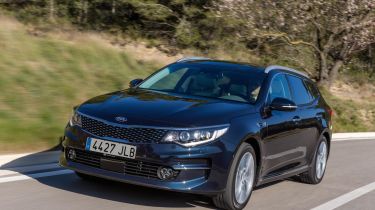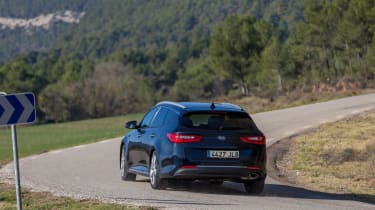Kia Optima Sportswagon estate (2016-2020) - Engines, drive & performance
Driving fun isn’t high on the agenda for the Kia Optima SW, but the GT model is better
The Kia Optima SW isn’t drastically different to drive from the Optima saloon – which is to say it’s a smooth, comfortable and refined companion on the road, but not particularly thrilling or engaging for the driver.
If you’re after driving fun in this class, the Mazda6 Tourer is still the top choice. The engineer previously in charge of developing BMW’s sporty M cars is now working for Kia and his influence could well be felt when the sportier Optima GT joins the range in early 2017.
For now, there’s more of an emphasis on comfort than sharp responses with the SW, which rides bumps reasonably well, but leans a bit too much in corners to inspire real confidence when driving quickly. It’s more at home cruising gently on a smooth A-road or motorway.
Kia has also tweaked the Optima SW’s suspension slightly to take account of the fact it has slightly more weight towards the rear than the Optima saloon and is more likely to be used for carrying heavy loads.
Kia Optima Sportswagon diesel engine
Kia’s 1.7-litre CRDi diesel engine is the sole option for powering the Optima SW – there’s no petrol alternative for UK buyers, unless you go for the GT model; however, a plug-in hybrid version is expected to join the range at some point in the future.
The diesel makes 139bhp and has plenty of shove on tap for overtaking, towing and making progress on the motorway – although it can feel a bit sluggish pulling away at first. It’s not massively quick against the stopwatch, either: 0-60mph takes 9.8 seconds for the manual and over 10 seconds for the automatic.
More reviews
The manual is precise and pleasant to use, while the automatic lets you shift gears yourself should you want to using paddles mounted on the steering column, although these are a little on the small side for use when you’re in a hurry.
The automatic also provides the Optima SW with a driving mode selection function. You can choose from Normal, Eco and Sport modes to tweak how the car behaves in order to prioritise efficiency or performance as required. The drop in acceleration from 9.8 to 10.7 seconds seems dramatic on paper, but the reality is that power feels very effectively managed and kickdown acceleration available in a responsive fashion. Overtaking is made easy and safe, but it’s not as fun to drive as the manual.
Petrol engine
The performance-orientated Optima SW GT has 242bhp 2.0-litre turbocharged petrol engine and a six-speed automatic gearbox. It also features lowered adaptive suspension to make the driving experience more involving. The SW GT is a successful package, which transforms the standard Optima SW into a pretty decent driver’s car, but the standard six-speed automatic gearbox can be slow to change down a gear when accelerating at high speed. Our test drive also left us feeling a little more power would be welcome. That’s partly a testament to Kia’s engineers, though, as the Optima SW GT’s steering, brakes and suspension have been so successfully tweaked we feel they could easily cope with 280bhp or so.













